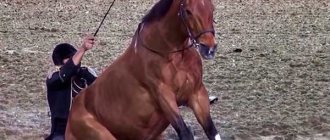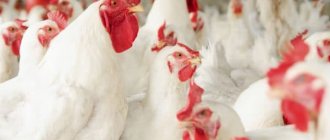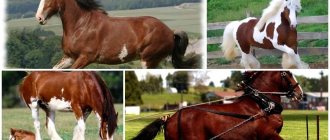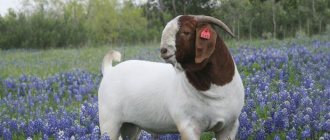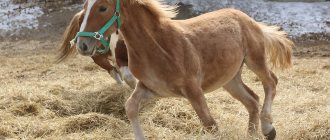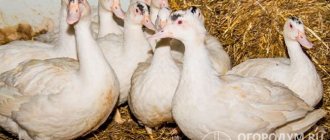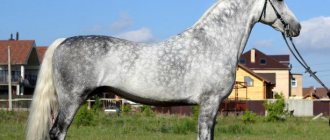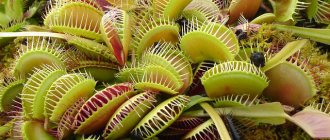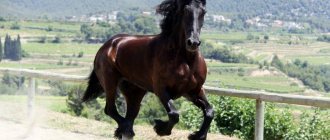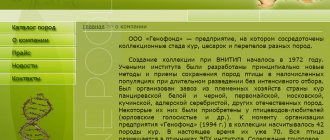The ancestors of modern Percheron horses served in military cavalry, carried knights in heavy armor during the Crusades, participated in the Napoleonic Wars, and during the time of the Count of Monte Cristo they transported Parisian stagecoaches and omnibuses.
The Percheron region in the south of France with favorable climatic conditions and rich pastures is considered to be the birthplace of the Percheron breed. It was there that large and hardy horses, the ancestors of modern heavy draft horses, were bred for agricultural needs.
Origin story
It was bred in France at the beginning of the 19th century by crossing eastern, mainly Arabian, stallions with a local heavy Western type draft breed.
Percherons began to be imported into Russia in the 19th century.
The Percherons got their name from the lush pastures of the Perche region of their upbringing, located south of the mouths of the Seine River.
They represent a purebred Norian horse, containing a very variable admixture of oriental blood; resort to such crossing was forced by the need for strong and fast horses needed for postal chasing and omnibuses.
In the Perche region, uncrossed heavy draft horses were also bred, as well as a lot of imported large horses of gray and black color, bought all over France.
Thanks to the same color, luxurious food and monotonous method of education, all these horses are very similar to each other, but still, the totality of Percherons is a product of local conditions, and not of deliberate, expedient breeding.
This breed is simply strong, tall, suitable for walking and moderate trotting - in a word, something between a real heavy draft and an agricultural one.
In France, they are distinguished by height: large, medium and small Percheron. The most common is medium.
In 1941, in the USSR there was a State pedigree horse breeding nursery for the Percheron breed, it was located at Art. Talovaya, Voronezh region.
In Russia, Percheron horses are raised only in the Ulyanovsk region at the Oktyabrsky stud farm. At the moment, the situation of the plant and all its inhabitants is deplorable: horses are being sold to another plant for debts.
Arden
The Ardennes are the oldest breed of horse. Its homeland is the mountainous regions of the Ardennes, located on the border of Belgium and France. Horses were needed here to move heavy loads along mountain roads. A strong, short horse - and the height of the Ardens does not exceed 160 cm - was ideal for this mission. The Ardens even had to take part in Napoleonic wars - they had to transport large guns.
It is believed that the Ardenes descended from the ancient Solutre breed, which lived in Europe about 50 thousand years ago. The history of the Ardennes breed begins in the 19th century. Then their height reached 140 cm. These horses are small compared to other heavy draft horses, therefore they are known as “small draft horses”.
During the Napoleonic Wars, Ardennes began to be crossed with Arabian horses to increase the endurance of the latter. It was the Ardennes breed that was used to breed the famous Russian heavy trucks. In 1900, during the next exhibition of breeds held in Paris, the latter were presented as “Russian Ardennes”.
Description of the breed:
- Height – 152-163 cm.
- Color: bay, red or dark red, roan.
- Exterior. The head is large, with a low forehead and large expressive eyes. Pointy ears. The neck is arched, the shoulders are strong. The profile is smooth. The body is compact and massive. The legs are short, strong, covered with thick brushes.
- Usage. Workhorse. Obtaining horse meat.
Description of the breed
Photo:
The uniqueness of the Percheron lies in the fact that, under the influence of two different breeds, it combined the power and strength of a heavy draft horse with the grace, dryness and mobility of Arabian horses.
These horses are massive and incredibly strong. These are practically the only representatives of their species capable of walking under harness for a long time without stopping.
Unlike other heavy trucks, the Percheron is capable of combining fast running and moving large loads.
The harmonious build of these magnificent animals ensures the ability to maintain a soft ride at any gait. The horse has an impressive chest and powerful physique, while being agile and graceful.
Percheron exterior:
- Height at the withers: stallion - 1 m 62 cm, mare - 1 m 60 cm;
- Body length: stallion - 1 m 69 cm, mare - 1 m 69 cm;
- Chest girth: stallion - 2 m 02 cm, mare - 1 m 97 cm;
- Pastern girth: stallion - 24.4 cm, mare - 22.7 cm;
General characteristics
Percherons have a head shape characteristic of all heavy trucks. She is not particularly large compared to her large body, but she is quite expressive.
The forehead is large, the ears are long, the nose is slightly flattened. The neck is well set and of medium length. At the withers you can notice the elevation characteristic of strong horses.
The croup is straight. A large, muscular back that provides the horse with a smooth ride and maneuverability.
There are two types of French Percherons:
- small;
- big.
The Small Percheron used to be more popular because it was universal. It was used both as a workhorse and for carriages.
It was often called a post horse, since before the advent of the railroad, mail was delivered with the help of a small percheron.
This variety has more pronounced features of Arabian horses. The small Percheron, in comparison with the large one, is more graceful and drier-built.
The large Percheron is closer in size to the Norman draft horses. It was used in agriculture and for moving various heavy objects.
If the maximum height at the withers of a small Percheron reaches 160 cm, then for a large one this is only the minimum size.
The largest horse of this breed reached a height of 213 cm at the withers. Moreover, the weight of the horse exceeded 1000 kg.
Suit
Initially, Percherons were of different colors, but as a result of a certain demand, the gray in apples was recognized by the French as the main one.
In modern stables, gray and black representatives of this breed predominate. Roans and red ones are found, but much less common.
Mane and tail
Percherons have a surprisingly thick, long and airy mane. The tail is long, set low.
Previously, tail docking was a mandatory procedure to enhance comfort when riding in harness.
Subsequently, representatives of the Humane Society were able to prove that the horse was suffering, unable to ward off insects. Since then they stopped docking the tail.
Legs
The shape of the Percheron's legs differs significantly from other breeds. The limbs are dense and muscular.
The forearms are of standard length, with the pasterns being shorter and more muscular. The joints are powerful and large.
Character
Like the vast majority of large, powerful breeds, Percheron horses are a bit slow.
At the same time, they are patient, calm and absolutely calm. All these qualities are perfectly combined with the liveliness and mobility of the horse.
These horses easily and quickly learn new skills, and the acquired ones are retained for a long time. Percherons do not suffer from the obstinacy and pickiness inherent in thoroughbred horses.
Percheron size
The size of a Percheron depends on its purpose. Horse breeders mainly breed medium and large-sized Percherons. Their height varies from 1.5 m to 2 m and above. Small-sized Percherons are extremely rare. The title of “the largest horse in the world” belongs to a stallion of this breed, which reached more than 2.13 meters at the withers and weighed 1.37 tons.
Hero of French blood
Productive qualities
The Percheron is one of the most popular French horse breeds.
This popularity was determined by the characteristics of the breed:
- endurance;
- dry physique;
- harmonious proportions;
- massiveness, muscularity;
- agility, agility, grace;
- smooth ride. The perfect combination of power and grace allowed the breed to become universal.
Percherons are bred not only to improve the qualities of some existing breeds, but also to create new ones. All over the world they participate in various parades, horseback riding, and sleigh rides.
The largest individuals help move heavy loads (cars, trams, plows, carts) in rural areas or difficult to navigate places.
So, in Disneyland and Paris, these horses not only give rides to children, but also help pull out trams stuck in the park. The British use them for advertising, forestry and farming.
The calm disposition allows Percherons to be widely used in circus performances.
Character and disposition
The character and disposition of the Percheron deserves special attention. These horse breeds are incredibly smart, kind, flexible and not picky. They have a calm nature, patience and the ability to learn. Another positive quality of Percherons is their energy, mobility and soft movement, despite their power and heaviness.
Learning ability
Price
You can buy a Percheron in almost any country in the world, they are so common. The price for a healthy and strong horse between 5 and 10 years old ranges from 8 to 10 thousand dollars.
You can buy a six-month-old foal for a lower price, but in order for it to become a good animal, you need to invest a lot of money and time in this matter.
The more famous ancestors in a horse’s pedigree and the purer the blood, the higher the price.
Reviews
According to farmers, the advantages of the breed include:
- soft ride (regardless of gait);
- unpretentiousness;
- calm disposition and magnificent mind;
- quick adaptation to any conditions;
- power, endurance;
- high performance;
- good immunity.
There are also disadvantages:
- late maturity (as with all draft horses);
- due to large dimensions they are difficult to manage;
- If you do not combine proper nutrition with physical activity, they can gain excess weight.
Dutch draft
The massive Dutch draft horse is a breed of draft horse that resembles the Belgian draft horse and Ardennes horse in build and appearance. A few years after the First World War, the Dutch Draft was developed by crossing local Zeeland-type mares with Brabant and Ardennes stock.
It was one of the most popular horse breeds in the Netherlands. After World War II, increased mechanization and motorization led to a decline in the draft horse population, making the breed relatively rare. However, representatives of this breed can still be found at agricultural shows or plowing competitions.
The Dutch Draft has a calm, friendly and obedient temperament. The horse is of strong build, the head is straight, the chest is strong and muscular. The hind and lumbar parts are stocky, the legs are abundantly covered with hair. The color comes in several colors: chestnut, bay, gray, and sometimes black. Maximum height 173 cm, weight up to 750 kg.
Breeding
The process of self-breeding Percheron beauties requires certain knowledge about the breeding characteristics of this breed:
- the pregnancy of a Percheron mare , because initially the horse is quite large. Therefore, it is necessary to pay attention to changes in the female’s behavior. The emergence of a desire to defend the territory, as well as aggressiveness towards other horses living with it and increased appetite are the main signs of a horse’s pregnancy. This period lasts from 340 to 350 days, depending on the sex of the foal as well as the season.
- It is important to carefully monitor the pregnant mare's nutrition. Roughage should be minimized, giving preference to the highest quality products. During the third trimester, the horse should receive the maximum amount of nutrients through feed.
- Foals of this breed mature quite late - 2 years after birth. During this time, it is important that their physique becomes correct and their bones become stronger. This is why it is necessary for little Percherons to spend a lot of time outdoors. We should also not forget about a sufficient amount of food to replenish the supply of nutrients and energy for such active animals.
- Even at a young age, horses of this breed show an amazing ability to adapt, so you don’t have to worry about the foals spending a lot of time outdoors.
- If you want to breed a breed for sport riding or hunting , then you need to cross the Percheron with a lighter breed.
- It is also worth remembering that it is officially prohibited to dock the tails of these horses , since this procedure deprives the animals of the opportunity to protect themselves from insects in the summer.
Australian draft
The Australian draft horse is a breed of domesticated horse that evolved in Australia by crossing four purebred breeds: Clydesdale, Percheron, Shire, and Suffolk Punch. This cold-blooded horse species is known for its extraordinary endurance, strength and even temperament.
As the name suggests, in the past they were used for heavy agricultural work, pulling carriages and railroad cars to docks and sidings. However, with the advent of technology, machines replaced animals and the population of these horses declined. However, nowadays this energetic and friendly breed is widely used in various competitions, as well as as pleasure riding animals.
The Australian draft has a muscular build with a medium-length neck, broad chest and hips. The bottom of the legs is covered with wool. The color can be black, white, brown, gray or roan. Size from 162 to 175 cm. Weight from 600 to 900 kg.
Content
To maintain cleanliness in the stable, it is necessary to remove excrement and wet bedding every day. Once every seven days, the stables are thoroughly cleaned using disinfectants.
Feeders and drinking bowls will also be disinfected.
The cleanliness of an animal is the key to its health. Horses are brushed every time they are taken out of their stall and after a busy day before entering their stall.
When you tidy up your horse's coat with a brush, you not only remove dust, dirt, and debris, but also massage the skin, improving blood circulation.
During such a procedure, abrasions or other flaws on the skin can be detected, and these should be treated in a timely manner.
The mane and tail require special attention. They need to be combed thoroughly.
Ears and nostrils are examined and cleaned. In hot weather, swimming is a must, and after hard work, a contrast shower.
Feeding
Since Percherons are working horses, the amount of feed they consume should directly depend on their physical activity. The harder they work, the more varied and nutritious the food should be.
Regardless of the load, they need to be fed three to four, or even five times a day. When young greenery appears, the horses are taken out to pasture.
As additives to green feed, they are given compound feed, vitamins and minerals. In winter, grass is replaced with hay and straw.
Such a massive animal should receive at least 20 kg of hay for every 0.5 ton of its weight. Both winter and summer menus need to be diversified with concentrates, root vegetables, and roughage.
Be sure to give meat and bone meal, oil cake, and lick.
Important! Like all heavy draft dogs, Percherons are prone to obesity, so daily exercise is essential for them. In summer this can be regular grazing, in winter it can be 12-kilometer walks or work.
To maintain water balance, a horse needs 4-5 buckets of water per day. In hot weather, its amount doubles. Young animals must be grazed.
They should spend half the day on the pasture, eating fresh grass, the other half in the stall, on dry food. In the summer, their menu should include clover and lungwort.
At the age of 15-19 months, oats are introduced into the diet. They feed 5-6 times a day. In addition to grass, they provide roughage, root vegetables and concentrates.
Any horse should not be given: fresh bread; vegetables (exception: carrots); fruits (except apples, watermelon); dried fruits; sweets; wheat; corn; barley.
Stable care
Percherons are far from small animals, so when building a stable you need to take into account that they require much more free space than other horses.
In cold weather, it is more convenient to keep them in a stall, the dimensions of which should be 370 x430 cm. The ceiling height should be maximum. This will ensure good ventilation.
It is desirable to have a solid wall in the stall, turning into a wooden sheathing. This wall design will protect the animal from possible drafts, will not block the view and create obstacles to communication with its relatives.
Comfortable temperature is 5-15 °C, and humidity is 70%. To maintain the desired microclimate, it is advisable to insulate it when constructing a stable, especially in regions with cold winters.
To prevent the horse from suffering from hoof diseases, the floor in the stall is covered with a layer of sand, peat, straw or sawdust. This bedding will keep you dry.
Sources of daylight in warm weather are windows; in cold weather, lamps come to their aid, creating an illumination of 150-200 lux.
Disease Prevention
The French heavy truck's immunity is quite strong, so it is not often overcome by diseases.
To minimize the likelihood of a particular disease occurring, it is necessary to properly care for the animal.
Regular cleaning of the skin will relieve the horse of skin diseases. Even if a problem has arisen, in this case it will be detected in a timely manner and stopped at an early stage of development.
Hair trimming in winter will also help avoid the manifestation of various infectious diseases. It is equally important to monitor the horse’s equipment.
An incorrectly fitted saddle or harness can easily cause skin diseases.
You should also carefully monitor your diet, then everything will be fine with your digestive system.
Feeding
French breeders of the breed have developed a universal feeding scheme suitable for all ages and living conditions of animals.
According to it, feeding should occur five times a day, always at the same time period.
The diet consists of:
- juicy grass – 50%;
- concentrated feed – 20%;
- rough types of food – 20%;
- root crops – 10%.
During the mare's pregnancy, all roughage is completely excluded from her diet, replacing their volume with succulent grass.
Important! Fortification and replenishment of essential microelements is carried out with the help of veterinary drugs. The animal must have 24/7 access to clean water.
Breeding prospects
Versatility is a big advantage of Percherons. A big plus for them is their unpretentiousness in maintenance, so such a horse is very useful on the farm. But their price is high.
In order for the maintenance of an animal to be profitable, it is more advisable to start it on those farms that are located in the rural outback, and where road transport cannot reach, and the need for traction power is very high.
In this case, the horse will become an indispensable assistant when performing heavy work of any complexity.
It is believed that heavy trucks in the modern world are inferior in popularity to horses.
Due to their massive size, they cannot compete at races. But this is not about Percheron. Although they won’t be able to outrun riding horses, they have no equal in other types of equestrian sports where strength is needed.
Where can the horse be used?
It is believed that the French Percheron horse appeared as a result of the mixing of heavy breeds from the west and Arabian horses from the east. Nowadays he is considered very popular as he is involved in many areas of life.
Initially, the horse was famous for its heavy weight, which allowed it to cope with various tasks in agriculture. He harnessed himself to a cart and often plowed the land. It is known from history that such representatives immediately became popular due to their versatility. They helped people with their work and were very good transportation. Horses were bred not only in France. Very often, they were bought by residents of America, Canada and Japan, and Latin America, where they then began to breed them.
When people realized that the Percheron horse was very useful, special clubs began to open where they were engaged in breeding purebred representatives.
The first community was opened in the USA. There were expensive pure breed horses here, which were bred for the benefit of the country. When the population was already large, horses began to be trained for field work. These heavyweights could do a lot of work in just a few hours.
With the development of technological progress, the Percheron breed became less popular, and in parallel, the sports and entertainment industry began to develop, which again became the basis for breeding this breed. Equestrian sport welcomes such representatives.
Interesting Facts
- Jean de Birn was recognized as the best manufacturer in the 19th century. He gave birth to a large number of the most valuable representatives of the breed;
- In 1991, a beer company purchased four stallions of this breed for an advertising campaign. They carried a beer barrel with the inscription “Baltika” in the northern capital. The company subsequently purchased several mares for breeding;
- The famous circus actress Yana Sharikova performed in the arena for a long time with a magnificent specimen of the breed named Pompey. Their joint performance with hoops always delighted the audience;
- In France, horses of this breed are still bred en masse. For the French, the Percheron has not only commercial value, but is also considered a national treasure of the country. The government consistently devotes resources to breeding and improving the breed;
Development of Percherons
Mares of this breed produce a sufficient number of offspring. Percheron foals take a long time to mature. The childhood period lasts up to two years. For the rapid development of Percherons, sufficient food is required. Although on walks they happily eat pasture. It is especially important for the development of foals to exercise a lot.
Due to the ability to adapt to any climatic conditions, Percheron foals can be kept on pastures almost all the time. Constant loads form the correct physical build, promote muscle development and have a beneficial effect on the general condition of the foal.

